Abstract
Growing ageing population today may be necessitating building design decision makers to reconsider the indoor environmental quality (IEQ) standards in a way that accommodates senior occupants’ diverse and individual needs and demands. An experience design approach to rationalising and individualising end-user experience on how to utilise tangible products may serve to reflect user perceptions. Generally, architectural design practices tend to incorporate neither IEQ monitoring and analysis data, nor environmental experience design today. In response to the need for filling this gap, the authors of this paper conducted a feasibility study previously that led to structuring and defining an ‘Environmental Experience Design’ (EXD) research framework. Based on the previous case study on the collective spatial analysis and IEQ monitoring results, this paper further explored the usability and applicability of this proposed EXD framework particularly to the previously documented aged care facility in Victoria, Australia, which has been stressing active ageing agendas. This EXD framework usability experiment helped to build the capacity for engaging the subjectivity and objectivity of end users’ expectations, desires, and requirements in the architectural design thinking process. Nonetheless, due to the limitation of this initial and fundamental usability study’s resources and the objective, the necessity of adjusting the scale and scope of EXD analyses emerged. Moreover, the universality of this EXD research framework usage under various architectural typologies and user conditions yet require further attempts and investigations.
1. Introduction
The population of Australia is ageing [,,]. There were 3.5 million senior citizens who were aged 65 years and over in 2014 taking up 15% of the population []. It is estimated that the proportion of senior citizens will rise to 26% in 2051 and to 27% in 2101 [,,]. The population of Victoria follows the tendencies shown in the wider Australian population (Table 1). As of September 2017, the estimated Victorian population was 6,179,249 []. This is an increase of almost 23% since June 2005 []. Residents aged 55 and over cover nearly a quarter of the population (22.4%) and those aged 65 years and above form 16.7% of Victoria’s population []. The proportion of the population aged 65 years and over is expected to go up to 17.4% in 2021, 18.8% in 2031, 20.4% in 2041, and 21.8% in 2051 []. The greatest proportional shift in next few decades to be expected is the number of Victorians aged 85 years and above is projected to increase from 2.6% of the population in 2017 to 4.6% in 2051 []. There were 27% of the population aged 65 and over born in a non-English speaking country in contrast to 20% born domestically [].

Table 1.
Population of people aged 55 years and over in Victoria [].
The rise of senior population in Victoria led to the increase of aged care facility establishments and the architectural design may need to serve as an agent of engagement for societal needs. The design decisions today tend to be made without favouring user experiences and this challenge might be derived from the discrepancies between prescribed building codes and user perception. The role of built environments may become more prominent in managing increasing sensitives and vulnerabilities that come with ageing. As the Australian population ages, the state of Victoria is actively working towards facilitating effective spatial design strategies through an integrated framework for “active ageing” (Figure 1) [,,,,,,,].
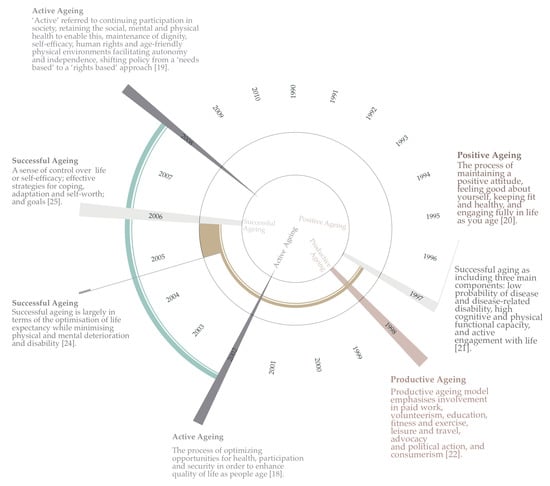
Figure 1.
Aged care agenda timeline.
It is worth noting that the “experience design” has already been applied to industrial designs and the “user experience design” focuses on improving products’ interface to facilitate the usage in response to end-users’ diverse physical and psychological needs and demands []. Pine and Gilmore (1999) stress that experience designs encompass both passive and active participation of end-users []. Architectural design has an impact on users’ physical and perceived comfort levels in the built environment. Nonetheless, the notion of such experience design is barely applied to architectural design practices today.
Data analysis or ‘programming’ facilitates stakeholders’ design orientation in response to the project objectives identified for the achievement []. De Giuli et al. (2012) articulates the significant impacts of indoor environmental quality (IEQ) research around thermal, acoustic, and visual conditions, as well as air quality on occupants’ health and wellbeing in the built environment []. IEQ data collected and/or simulated may provide some insights or indications of what the building in question can perform to maintain the acceptable levels of the occupants’ health and wellbeing []. Therefore, IEQ standards need to be well incorporated into architectural design decision making; nonetheless, it may be worth noting that these physical indicators alone need not reflect occupants’ perceived quality. Neither does the environmental design data itself serve as a direct architectural design decision-making tool.
This study explores this challenge through implementing an ‘Environmental Experience Design’ (EXD) research framework, which was previously proposed by this paper’s authors who reviewed the related theories that help to illustrate human physical and psychological needs and demands []. The proposed EXD framework devises “function analysis” techniques that help to categorise occupants’ requirements, desires and expectations in the built environment []. This study tested the proposed EXD research framework as a systematic approach to further identifying relevant design solutions towards activating senior citizens for the improvement of their health and wellbeing.
2. Environmental Experience Design Research Framework Review
A human-environment integrated approach that assists architectural design stakeholders in understanding the occupants’ physical and psychological needs and demands is required. In response to this need, the authors of this paper proposed a conceptual ‘Environmental Experience Design’ (EXD) research framework in 2017 []. This proposed EXD framework was designed to identify overall project objectives, analyse user perception, and propose design strategies and solutions. It is an interdisciplinary trajectory that is relatively new to architectural practices, aimed at embracing a human-environment integration into the design decision making process. The EXD framework devises a function analysis methodology that helps to identify “performance of a user function” and refine the design procedure to “fulfil a user requirement” by questioning what user needs are and how designers meet them []. The Function Analysis System Technique (FAST) diagram is first generated as a process to logically visualise the project’s key objectives or functions for prioritisation. The FAST diagram serves as a map or pathway towards the scrutiny of possible design solutions in response to the users’ physical and psychological needs and demands identified (Figure 2).
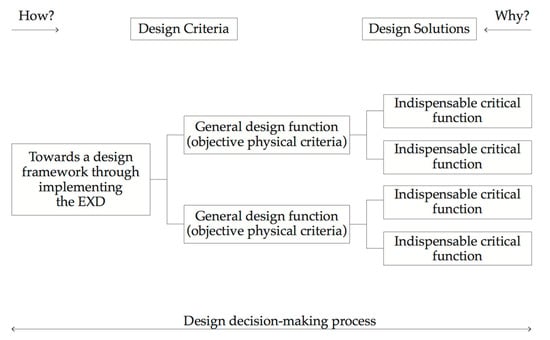
Figure 2.
General Function Analysis System Technique (FAST) diagram image.
Contextualising the human-environment relationship is of importance in the built environment, since the space affects users’ activities of daily living [,]. Spatial design strategies need to be set in a way that matches both objective physical parameters (e.g., natural and built environment settings) and subjective user perception (e.g., psychological needs and demands). In the EXD research framework, in response to FAST implementation results, user experience related functions and the associated spatial design strategies and solutions are contextualised through the development of a human-environment matching ‘EXD evaluation matrix’ (Figure 2) []. The enumeration helps to visualise the relationship between the occupants’ physical and psychological requirements, desires and expectations, and the potential architectural design strategies and solutions applied to shaping the space accordingly.
The EXD research framework was developed conceptually as a tool that any stakeholders can apply to identifying projects’ objectives and relevant design solutions (Figure 3). Nonetheless, the actual usability and applicability are still in question. Thus, the following sections will demonstrate how this conceptual EXD tool can be applied to upgrading a selected aged care facility in Victoria, Australia, in consideration of the Victorian government’s active ageing agenda.
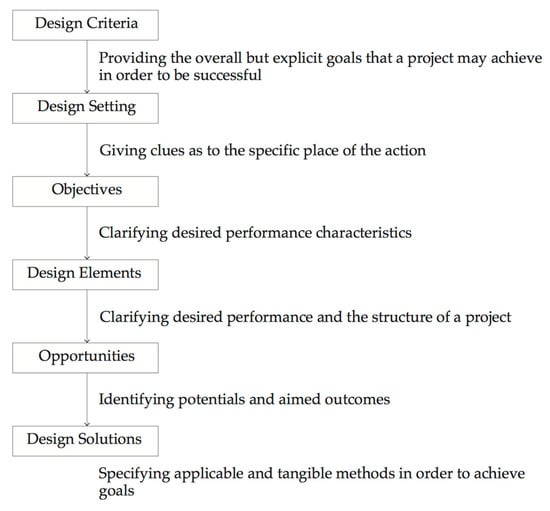
Figure 3.
Environmental Experience Design (EXD) matrix evaluation process for human-environment element integration.
3. Proposed EXD Framework Implementation
This study revisited an aged care facility located in Victoria, Australia, with the aim to test the usability and applicability of the Environmental Experience Design (EXD) research framework proposed initially by authors of this paper in 2017 (Figure 4) []. It is also aimed at demonstrating the human-environment matching mechanism oriented towards activating the senior residents for their health and wellbeing.
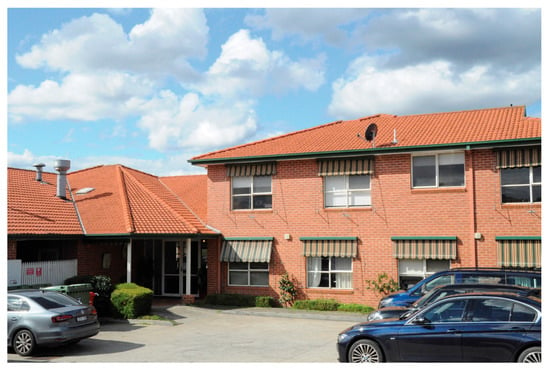
Figure 4.
Exterior view of Adare SRS studied.
To make sure that the selected aged care facility was designed to maintain the minimal levels of physical indoor environmental quality (IEQ) conditions, IEQ monitoring of the temperature, and the levels of particulate matter and carbon dioxide concentration was conducted over a one-week period from 29th May to 4th June 2017 (Figure 5) []. The study confirmed that the overall IEQ conditions were generally satisfactory. Nonetheless, it also led to stressing a potential consideration, as indicated “Although the thermal condition of both bedroom and communal space are in the lower range of thermal comfort zone defined by ANSI/ASHRAE Standard 55-2013, a warmer environment is recommended … the 20–24 °C comfort zone is not warm enough for older adults and older adults generally prefer a warmer environment than younger subjects” (Figure 6) [].
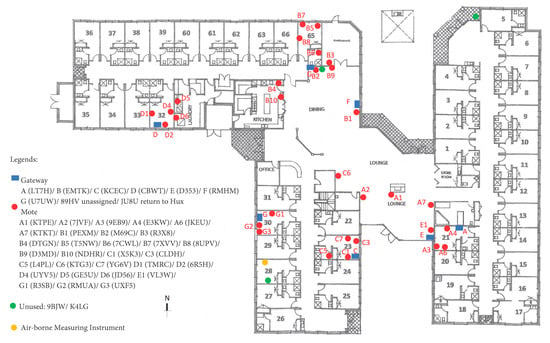
Figure 5.
Locations of Indoor Environmental Quality (IEQ) Measurements.
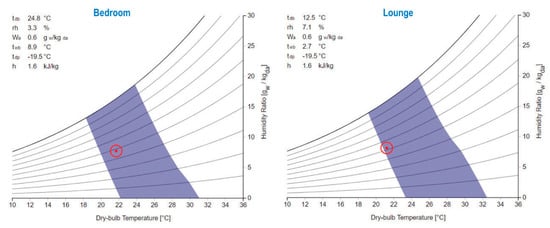
Figure 6.
Thermal condition of the bedroom (left) and lounge space (right) in psychometric chart. The shaded areas represent comfort zone boundary [].
Based on the spatial analysis of the aged care facility revisited, the EXD FAST diagram was developed with the aim to outline the relevant functions that reflect the senior residents’ general needs and demands around their activities of daily living, as well as to identify sensitive spaces and the upgrading approaches to activating the elderly physically and psychologically. The function analysis aims to encompass both the subjectivity and objectivity of users’ needs and demands; therefore, all stakeholders including not only the residents and visitors but also designers and builders may ideally be involved in the thinking process. Nonetheless, due to the main aim of this study that attempts to demonstrate and analyse the framework usability, the EXD FAST diagram was shaped by the researchers who observed, documented, and analysed the building, in addition to the IEQ monitoring on behalf of the stakeholders (Figure 7).
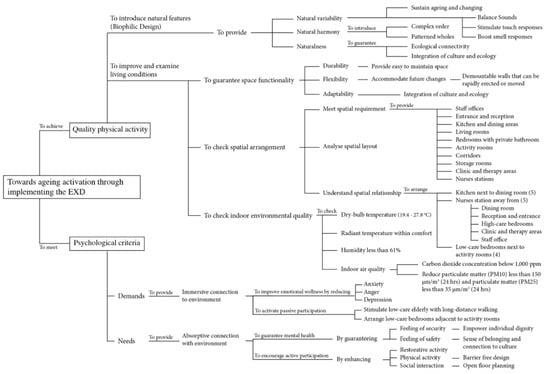
Figure 7.
EXD FAST diagram of senior residents’ physical and metaphysical functions.
Based on the observations of the spatial settings throughout the ground floor, level differences are well avoided, and this inclusive design fundamental allows for enhanced accessibility and safety of the senior users with mobility aids. Partitions set between the dining and kitchen area tend to discourage visual and physical interaction, while limiting the circulation of unfavourable smells. Staff areas, including the office, reception, and nurses’ station are located next to the dining room, which serves as the residents’ social activities. The bedrooms were dimensionally adequate and were lit by natural light coming through the transparent window that is centered in the external wall. Outdoor spaces are equipped with accessible garden pedestrian paths, communal spaces with barbeque facilities, visually stimulating artefacts, and seasonal plants—those that to some extent contribute to the creation of atmosphere that supports the notion of active aging. Based on the spatial setting observation and FAST diagram results, an EXD evaluation matrix was developed with the aim of identifying the potential upgrading solutions that reflect the Victorian government’s active ageing agenda (Table 2).

Table 2.
EXD evaluation matrix enumerating potential senior users’ physical attributes and psychological perceptions towards identification of possible design solutions [].
In this study, the EXD evaluation matrix contents were further simplified and illustrated to articulate the selected aged care facility’s human-environment relationship (Figure 8). EXD visualisation serves as a medium that all stakeholders, such as the facility’s staff, users, visitors, and appointed architects, can understand today’s spatial circumstances and the future upgrading potentials that contribute to turning passive senior residents into active ones for their physical and mental health and wellbeing.
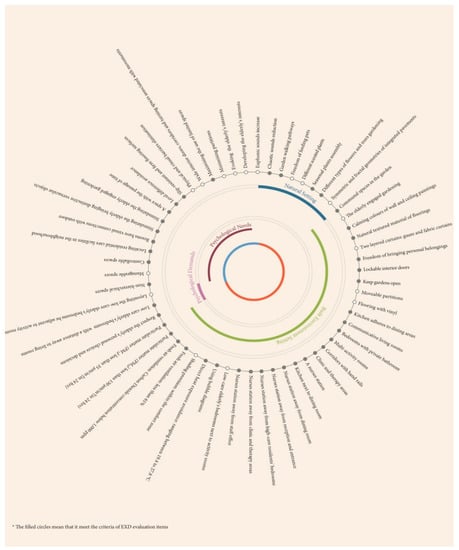
Figure 8.
EXD human-environment relationship visualisation.
EXD Spatial Upgrading Potentials
The EXD evaluation matrix was contextualised for value visualisation and it led to identifying some potential architectural design or space upgrading solutions for active ageing (Figure 9). Three spaces of the selected aged care facility were used for the demonstration of the proposed EXD framework. Before-and-after design upgrades of these selected spaces were illustrated based on the EXD evaluation outcomes. The annotations appearing in Figure 9, Figure 10 and Figure 11 reflect the design solutions that are listed on the 6th column from the left of Table 2.
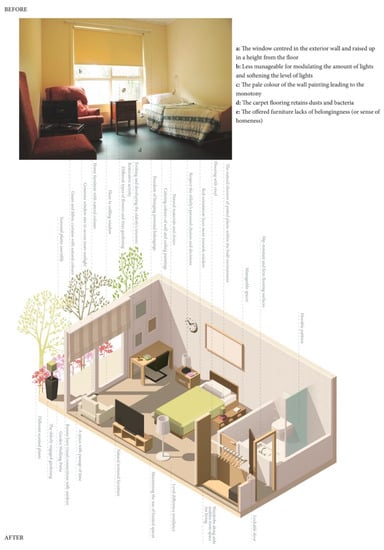
Figure 9.
An existing bedroom unit (top) and the EXD upgrading potentials (bottom).
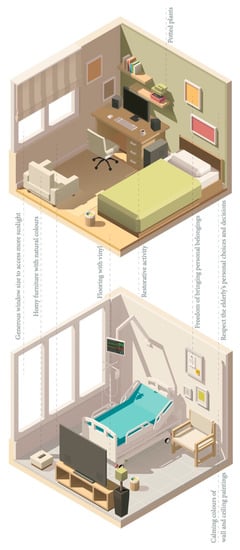
Figure 10.
An existing low-care room (top) and a suggested high-care upgrade (bottom).
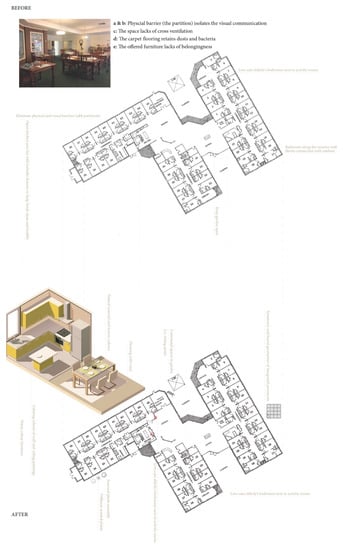
Figure 11.
Proposed articulation for visual and physical connectivity between spaces.
Suggestions for the minor renovation included: the replacement of fabric carpets with anti-bacterial titles for the elderly users’ smooth walk and enhanced sanitation; the change of existing window blinds to double-layered fabric curtains, which allow for more flexibility in modulating the intensity of natural light being introduced into the internal space; and, the introduction of indoor potted plants that encourage the senior residents’ engagement with nature in the controlled built environment. These renovations can be realised within the building’s existing structure, dimension, volume, and layout; nonetheless, some low-care units that are occupied by immobile senior users may desire major high-care upgrades (Figure 10).
Suggestions for the ground floor improvement extended to the relocation of low care bedrooms to places adjacent to rooms that embrace social and physical activities (Figure 11). This may create opportunities for immobile senior residents to be linked to visual and acoustic stimuli. The reduction of physical and visual barriers (i.e., open floor planning) might also lead to the enhancement of users’ social networking opportunities. Non-structural rigid partitions can be replaced with collapsible or movable partitions that can separate or open spaces according to the users’ specific needs and demands.
Outdoor settings may also need to be designed for enhancement of the senior occupants’ safety, accessibility, comfort, and stimulation for active ageing. Exposure to the full spectrum of natural light may contribute to activating the occupants along with humans’ circadian rhythms. The proposed designs included features that aim to promote visual, acoustic, and olfactory stimuli, and the placement of vegetation (and pets) would also serve as an active ageing driver. Dubos (1980) argues that “people want to experience the sensory, emotional, and spiritual satisfactions that can be obtained only from an intimate interplay, indeed from an identification with the places which [they] live” []. However, such human satisfaction may be continuously reliant on perceiving and responding to sensory variability []. Senses of sound, touch, and smell form the sensory richness []. Although walking pathways exist in the selected aged care facility, there is no intent or consideration of adding pleasant visual and olfactory stimuli to the users’ experience. If these spaces are equipped with interactive green gardens, senior residents may be more attracted to taking a stroll or even the upkeep.
4. Conclusions
The proposed ‘Environmental Experience Design’ (EXD) research framework was an attempt to connect the domains of environmental design and experience design. It addressed complexities of the human-environment relationship and served as a design decision-making support tool that helps visualise end-users’ needs and demands, as well as build a pathway towards identification of the associated design solutions. This study was an extension of the authors’ previous research project that conceptualised the EXD research framework itself. In this paper, the usability and application to a selected aged care facility’s spatial design upgrades for active ageing were explored and demonstrated conceptually. In addition to the IEQ building performance check, this EXD framework usability experiment helped to build the capacity for engaging the subjectivity and objectivity of end users’ expectations, desires, and requirements in the architectural design thinking process. Nonetheless, this study was limited to an initial and fundamental demonstration of the EXD decision making process that targeted the potential design improvements of a selected aged care facility in Victoria, Australia; therefore, the universality of this EXD research framework usage under various architectural typologies and user conditions still requires further attempts and investigations. Moreover, the scale and scope of EXD analyses need to be narrowed and focused much further for in-depth exploration of each functional space in the built environment, while the stakeholders’ direct involvement in the function analysis stage is necessitated to identify their precise perceived needs and demands rather than the speculations. A subsequent validation study of the EXD experiential effect on IEQ improvements may require further justification of the usability and universality.
Author Contributions
M.N. and N.M. led overall research activities and contributed to structuring the proposed environmental experience design diagnostic framework and writing this paper. C.M.M.W. contributed to the editorial coordination. H.-w.C. documented the aged care facility selected in Victoria. J.Z. contributed to the IEQ monitoring and data analysis.
Acknowledgments
The authors would like to express their sincere gratitude to Adare SRS which allowed them to access their aged care facility rooms for in-depth documentation and IEQ monitoring.
Conflicts of Interest
The authors declare no conflict of interest.
References
- Australian Bureau of Statistics. Australian Demographic Statistics, March 2017; Australian Bureau of Statistics: Canberra, Australia, 2017.
- Australian Bureau of Statistics. Population by Age and Sex, Victoria; Australian Bureau of Statistics: Canberra, Australia, 2006.
- Australian Institute of Health and Welfare. Australia’s Welfare 2011; Australian Institute of Health and Welfare: Canberra, Australia, 2011.
- Australian Institute of Health and Welfare. Australia’s Welfare 2015; Australian Institute of Health and Welfare: Canberra, Australia, 2015.
- Australian Bureau of Statistics. Population by Age and Sex, Australian States and Territories; Australian Bureau of Statistics: Canberra, Australia, 2011.
- Australian Bureau of Statistics. Health of Older People in Australia: A Snapshot, 2004–2005; Australian Bureau of Statistics: Canberra, Australia, 2006.
- Australian Institute of Health and Welfare. Australia’s Health 2010; Australian Institute of Health and Welfare: Canberra, Australia, 2010.
- Australian Bureau of Statistics. Population by Age and Sex, Victoria; Australian Bureau of Statistics: Canberra, Australia, 2016.
- Australian Bureau of Statistics. National Health Survey—First Results: Australia 2014–2015; Australian Bureau of Statistics: Canberra, Australia, 2015.
- Federation of Ethnic Communities’ Councils of Australia. Review of Australian Research on Older People from Culturally and Linguistically Diverse Backgrounds; Federation of Ethnic Communities’ Councils of Australia: Canberra, Australia, 2015.
- World Health Organisation. Active Ageing: A Policy Framework. 2002. Available online: http://apps.who.int/iris/bitstream/10665/67215/1/WHO_NPH_02.8.pdf (accessed on 26 September 2017).
- Bowling, A. Enhancing Later Life: How Older People Perceive Active Ageing? Aging Ment. Health 2008, 12, 293–301. [Google Scholar] [CrossRef] [PubMed]
- Kendig, H.; Browning, C. Positive Ageing: Facts and Opportunities. Med. J. Aust. 1997, 167, 409–441. [Google Scholar] [PubMed]
- Rowe, J.W.; Kahn, R.L. Successful Ageing. Gerontologist 1997, 37, 433–440. [Google Scholar] [CrossRef] [PubMed]
- Kerschner, H.; Pegues, J.A.M. Productive Aging: A Quality of Life Agenda. J. Am. Dietet. Assoc. 1998, 98, 1445–1448. [Google Scholar] [CrossRef]
- Kalache, A.; Gatti, A. Active ageing: A policy framework. Adv. Gerontol. 2003, 11, 7–18. [Google Scholar] [PubMed]
- Bowling, A.; Dieppe, P. What Is Successful Ageing and Who Should Define It? Br. Med. J. 2005, 331, 1548–1551. [Google Scholar] [CrossRef] [PubMed]
- Bowling, A.; IIiffe, S. Which Model of Successful Ageing Should Be Used? Baseline Findings from a British Longitudinal Survey of Ageing. Age Ageing 2006, 35, 607–614. [Google Scholar] [CrossRef] [PubMed]
- Hassenzahl, M. Experience Design: Technology for All the Right Reasons; Morgan and Claypool Publishers: Philadelphia, PA, USA, 2010. [Google Scholar]
- Pine, B.J.; Gilmore, J.H. The Experience Economy: Work Is Theatre & Every Business a Stage; Harvard Business School Press: Cambridge, MA, USA, 1999. [Google Scholar]
- Farbstein, J.; Wener, R.; McCunn, L.J. Planning the Built Environment: Programming. Research Methods for Environmental Psychology; Wiley: Malaysia, 2016. [Google Scholar]
- De Giuli, V.; da Pos, O.; de Carli, M. Indoor Environmental Quality and Pupil Perception in Italian Primary Schools. Build. Environ. 2012, 56, 335–345. [Google Scholar] [CrossRef]
- Al horr, Y.; Arif, M.; Katafygiotou, M.; Mazroei, A.; Kaushik, A.; Elsarrag, E. Impact of Indoor Environmental Quality on Occupant Well-being and Comfort: A Review of the Literature. Int. J. Sustain. Built Environ. 2016, 5, 1–11. [Google Scholar] [CrossRef]
- Ma, N.; Chau, H.; Zhou, J.; Noguchi, M. Structuring the Environmental Experience Design Research Framework through Selected Aged Care Facility Data Analyses in Victoria. Sustainability 2017, 9, 12. [Google Scholar] [CrossRef]
- Dell’Isola, A.J. Value Engineering: Practical Applications: for Design, Construction, Maintenance & Operations; R.S. Means: Kingston, NY, USA, 1997. [Google Scholar]
- Horgas, A.L.; Wilms, H.U.; Baltes, M.M. Daily Life in Very Old Age: Everyday Activities as Expression of Successful Living. Gerontologist 1998, 38, 556–568. [Google Scholar] [CrossRef] [PubMed]
- Krause, N. Neighborhood Deterioration, Religious Coping, and Changes in Health during Late Life. Gerontologist 1998, 38, 653–664. [Google Scholar] [CrossRef] [PubMed]
- Dubos, R. The Wooing of Earth; Scribner: New York, NY, USA, 1980. [Google Scholar]
- Kellert, S. Kinship to Mastery: Biophilia in Human Evolution and Development; Island Press: Washington, DC, USA, 1997. [Google Scholar]
© 2018 by the authors. Licensee MDPI, Basel, Switzerland. This article is an open access article distributed under the terms and conditions of the Creative Commons Attribution (CC BY) license (http://creativecommons.org/licenses/by/4.0/).